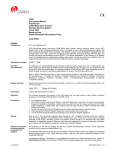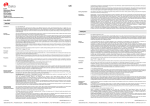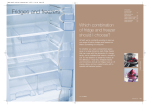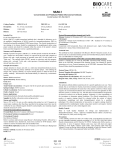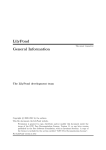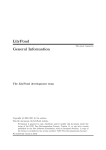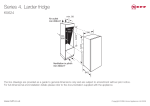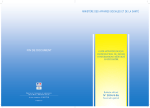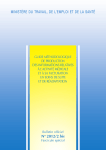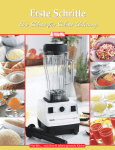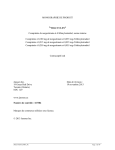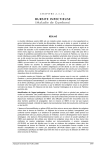Download FLEX Monoclonal Mouse Anti-Human Hepatocyte Clone
Transcript
FLEX Monoclonal Mouse Anti-Human Hepatocyte Clone OCH1E5 Ready-to-Use (Dako Autostainer/Autostainer Plus) Staining interpretation Hepatocytes labeled by the antibody display distinct, granular cytoplasmic staining, which is occasionally ringlike and is present diffusely throughout the hepatocyte cytoplasm without canalicular accentuation (4). Performance characteristics Normal tissues: In the liver, the antibody labels the hepatocytes. There does not seem to be any zonal preference in normal liver, but immediately adjacent to tumors decreased labeling in compressed hepatocytes may be observed. No labeling is observed in bile ducts or nonparenchymal cells. Skin, smooth and skeletal muscle, mesothelium, lymph nodes, spleen, lung, breast, esophagus, stomach, intestine, pancreas, biliary tract, kidney, urinary bladder, adrenal gland, prostate, endometrium, and ovary are almost all negative. The rare exceptions are focal, but often strong labeling of small bowel mucosa in a minority of cases. (4). Hepatocytes show a moderate to strong staining reaction. Abnormal tissues: Of primary hepatocellular carcinomas (HCC), 37/38 was positive with the antibody. 4 of the positive HCCs showed only rare positive cells. The negative case was a sclerosing HCC. Considerable variability from one area to another in the positive HCCs was observed. Of HCC metastases, 4/5 was positive (4). When a panel of 10 previously diagnosed clear cell hepatocellular carcinomas (HCC-CC) and 10 clear cell renal carcinomas (RCC-CC) was tested with the antibody, it demonstrated a specificity of 100% and a sensitivity of 90% in distinguishing HCC-CC from RCC-CC (2). In another study (1), comprising 65 liver tumors and 2 extrahepatic tumors from patients with documented liver tumors, the antibody showed an 82% sensitivity and 90% specificity for the detection of hepatocellular neoplasms (1). 12/12 hepatoblastomas were found positive with the antibody, while 26/26 selected childhood tumors, including 5 germ cell tumors, 4 peripheral neuroectodermal tumors/Ewing’s sarcomas, 3 rhabdosarcomas, 5 neuroblastomas, 2 rhabdoid tumors, 3 lymphomas, and 4 Wilms´ tumors, were negative (3). Focal positivity has been observed with the antibody in 6/7 hepatoid adenocarcinomas of the gastric tract. These rare tumors were also positive for alpha-1-fetoprotein and CEA (5). Code IS624 ENGLISH Intended use For in vitro diagnostic use. FLEX Monoclonal Mouse Anti-Human Hepatocyte, Clone OCH1E5, Ready-to-Use, (Dako Autostainer/Autostainer Plus), is intended for use in immunohistochemistry together with Dako Autostainer/Autostainer Plus instruments. This antibody labels hepatocytes and is useful for the differential diagnosis of hepatocellular tumors in general (1), for the differentiation of clear cell hepatocellular carcinomas from other clear cell malignancies (2), and for the distinction of hepatoblastoma, especially the embryonal type, from other small, round-cell tumors of childhood (3). The clinical interpretation of any staining or its absence should be complemented by morphological studies using proper controls and should be evaluated within the context of the patient's clinical history and other diagnostic tests by a qualified pathologist. Summary and explanation Refer to Dako’s General Instructions for Immunohistochemical Staining or the detection system instructions of IHC procedures for: 1) Principle of Procedure, 2) Materials Required, Not Supplied, 3) Storage, 4) Specimen Preparation, 5) Staining Procedure, 6) Quality Control, 7) Troubleshooting, 8) Interpretation of Staining, 9) General Limitations. Reagent provided Ready-to-use monoclonal mouse antibody provided in liquid form in a buffer containing stabilizing protein and 0.015 mol/L sodium azide. Clone: OCH1E5 (4). Isotype: IgG1, kappa. Immunogen Formalin-fixed, failed human allograft liver that was mechanically disrupted (4). Specificity The antibody labels an antigen that seems to be localized to the mitochondrial fraction of liver homogenates (4). Precautions 1. For professional users. 2. This product contains sodium azide (NaN3), a chemical highly toxic in pure form. At product concentrations, though not classified as hazardous, sodium azide may react with lead and copper plumbing to form highly explosive build-ups of metal azides. Upon disposal, flush with large volumes of water to prevent metal azide build-up in plumbing. 3. As with any product derived from biological sources, proper handling procedures should be used. 4. Wear appropriate Personal Protective Equipment to avoid contact with eyes and skin. 5. Unused solution should be disposed of according to local, State and Federal regulations. Storage Store at 2-8 °C. Do not use after expiration date sta mped on vial. If reagents are stored under any conditions other than those specified, the conditions must be verified by the user. There are no obvious signs to indicate instability of this product. Therefore, positive and negative controls should be run simultaneously with patient specimens. If unexpected staining is observed which cannot be explained by variations in laboratory procedures and a problem with the antibody is suspected, contact Dako Technical Support. Specimen preparation including materials required but not supplied The antibody can be used for labeling formalin-fixed, paraffin-embedded tissue sections. Tissue specimens should be cut into sections of approximately 4 µm. Pre-treatment with heat-induced epitope retrieval (HIER) is required using Dako PT Link (Code PT100/PT101). For details, please refer to the PT Link User Guide. Optimal results are obtained by pretreating tissues using EnVision FLEX Target Retrieval Solution, High pH (50x) (Code K8010/K8004). Paraffin-embedded sections: Pre-treatment of formalin-fixed, paraffin-embedded tissue sections is recommended using the 3-in-1 specimen preparation procedure for Dako PT Link. Follow the pre-treatment procedure outlined in the package insert for EnVision FLEX Target Retrieval Solution, High pH (50x) (Code K8010/K8004). Note: After staining the sections must be dehydrated, cleared and mounted using permanent mounting medium. Deparaffinized sections: Pre-treatment of deparaffinized formalin-fixed, paraffin-embedded tissue sections is recommended using Dako PT Link and following the same procedure as described for paraffin-embedded sections. After staining the slides should be mounted using aqueous or permanent mounting medium. The tissue sections should not dry out during the treatment or during the following immunohistochemical staining procedure. For greater adherence of tissue sections to glass slides, the use of FLEX IHC Microscope Slides (Code K8020) is recommended. Staining procedure including materials required but not supplied FRANÇAIS Utilisation prévue Pour utilisation diagnostique in vitro. FLEX Monoclonal Mouse Anti-Human Hepatocyte, Clone OCH1E5, Ready-to-Use, (Dako Autostainer/Autostainer Plus) est destiné à une utilisation en immunohistochimie avec les instruments Dako Autostainer/Autostainer Plus. Cet anticorps marque les hépatocytes et est utile pour le diagnostic différentiel des tumeurs hépatocellulaires en général (1), pour la différenciation des carcinomes hépatocellulaires à cellules claires d’autres tumeurs à cellules claires (2), et pour la distinction des hépatoblastomes, notamment de type embryonnaire, d’autres tumeurs à petites cellules rondes de l’enfant (3). L’interprétation clinique de toute coloration ou son absence doit être complétée par des études morphologiques en utilisant des contrôles appropriés et doit être évaluée en fonction des antécédents cliniques du patient et d’autres tests diagnostiques par un pathologiste qualifié. Résumé et explication Se référer aux Instructions générales de coloration immunohistochimique de Dako ou aux instructions du système de détection relatives aux procédures IHC pour plus d’informations concernant les points suivants : 1) Principe de procédure, 2) Matériels requis mais non fournis, 3) Conservation, 4) Préparation des échantillons, 5) Procédure de coloration, 6) Contrôle qualité, 7) Dépannage, 8) Interprétation de la coloration, 9) Limites générales. Réactifs fournis Anticorps monoclonal de souris prêt à l’emploi fourni sous forme liquide dans un tampon contenant une protéine stabilisante et 0,015 mol/L d’azide de sodium. Clone : OCH1E5 (4). Isotype : IgG1, kappa. Immunogène Foie humain d’allogreffe rejeté, fixé au formol, et ayant subi une lésion mécanique (4). Spécificité L’anticorps marque un antigène qui semble être localisé à la fraction mitochondriale des homogénats de foie (4). Précautions 1. Pour utilisateurs professionnels. 2. Ce produit contient de l’azide de sodium (NaN3), produit chimique hautement toxique dans sa forme pure. Aux concentrations du produit, bien que non classé comme dangereux, l’azide de sodium peut réagir avec le cuivre et le plomb des canalisations et former des accumulations d’azides métalliques hautement explosifs. Lors de l’élimination, rincer abondamment à l’eau pour éviter toute accumulation d’azide métallique dans les canalisations. 3. Comme avec tout produit d’origine biologique, des procédures de manipulation appropriées doivent être respectées. 4. Porter un vêtement de protection approprié pour éviter le contact avec les yeux et la peau. 5. Les solutions non utilisées doivent être éliminées conformément aux réglementations locales et nationales. Conservation Conserver entre 2 et 8 °C. Ne pas utiliser après la date de péremption imprimée sur le flacon. Si les réactifs sont conservés dans des conditions autres que celles indiquées, celles-ci doivent être validées par l’utilisateur. Il n’y a aucun signe évident indiquant l’instabilité de ce produit. Par conséquent, des contrôles positifs et négatifs doivent être testés en même temps que les échantillons de patient. Si une coloration inattendue est observée, qui ne peut être expliquée par un changement des procédures du laboratoire, et en cas de suspicion d’un problème lié à l’anticorps, contacter l’assistance technique de Dako. Préparation des échantillons y compris le matériel requis mais non fourni L’anticorps peut être utilisé pour le marquage des coupes de tissus inclus en paraffine et fixés au formol. L’épaisseur des coupes d’échantillons de tissu doit être d’environ 4 µm. Un prétraitement avec démasquage d’épitope induit par la chaleur (HIER) est nécessaire avec le Dako PT Link (Réf. PT100/PT101). Pour plus de détails, se référer au Guide d’utilisation du PT Link. Des résultats optimaux sont obtenus en prétraitant les tissus à l’aide de la EnVision FLEX Target Retrieval Solution, High pH (50x) (Réf. K8010/K8004). Coupes incluses en paraffine : le prétraitement des coupes tissulaires fixées au formol et incluses en paraffine est recommandé à l'aide de la procédure de préparation d'échantillon 3-en-un pour le Dako PT Link. Suivre la procédure de prétraitement indiquée dans la notice de la EnVision FLEX Target Retrieval Solution, High pH (50x) (Réf. K8010/K8004). Remarque : après coloration, les coupes doivent être déshydratées, lavées et montées à l’aide d’un milieu de montage permanent. Coupes déparaffinées : le prétraitement des coupes tissulaires déparaffinées, fixées au formol et incluses en paraffine, est recommandé à l’aide du Dako PT Link, en suivant la même procédure que pour les coupes incluses en paraffine. Après coloration, un montage aqueux ou permanent des lames est recommandé. Les coupes de tissus ne doivent pas sécher lors du traitement ni lors de la procédure de coloration immunohistochimique suivante. Pour une meilleure adhérence des coupes de tissus sur les lames de verre, il est recommandé d’utiliser des lames FLEX IHC Microscope Slides (Réf. K8020). Procédure de coloration y compris le matériel requis mais non fourni Le système de visualisation recommandé est le EnVision FLEX, High pH, (Dako Autostainer/Autostainer Plus) (Réf. K8010). Les étapes de coloration et d’incubation sont préprogrammées dans le logiciel des instruments Dako Autostainer/Autostainer Plus, à l’aide des protocoles suivants : Protocole modèle : FLEXRTU2 (volume de distribution de 200 µL) ou FLEXRTU3 (volume de distribution de 300 µL) Autoprogram : Hepato (sans contre-coloration) ou HepatoH (avec contre-coloration) The recommended visualization system is EnVision FLEX, High pH, (Dako Autostainer/Autostainer Plus) (Code K8010). The staining steps and incubation times are pre-programmed into the software of Dako Autostainer/Autostainer Plus instruments, using the following protocols: Template protocol: FLEXRTU2 (200 µL dispense volume) or FLEXRTU3 (300 µL dispense volume) Autoprogram: Hepato (without counterstaining) or HepatoH (with counterstaining) The Auxiliary step should be set to “rinse buffer” in staining runs with ≤10 slides. For staining runs with >10 slides the Auxiliary step should be set to “none”. This ascertains comparable wash times. All incubation steps should be performed at room temperature. For details, please refer to the Operator’s Manual for the dedicated instrument. If the protocols are not available on the used Dako Autostainer instrument, please contact Dako Technical Services. Optimal conditions may vary depending on specimen and preparation methods, and should be determined by each individual laboratory. If the evaluating pathologist should desire a different staining intensity, a Dako Application Specialist/Technical Service Specialist can be contacted for information on re-programming of the protocol. Verify that the performance of the adjusted protocol is still valid by evaluating that the staining pattern is identical to the staining pattern described in “Performance characteristics”. Counterstaining in hematoxylin is recommended using EnVision FLEX Hematoxylin, (Dako Autostainer/Autostainer Plus) (Code K8018). Non-aqueous, permanent mounting medium is recommended. Positive and negative controls should be run simultaneously using the same protocol as the patient specimens. The positive control tissue should include liver and the cells/structures should display reaction patterns as described for this tissue in “Performance characteristics” in all positive specimens. The recommended negative control reagent is FLEX Negative Control, Mouse, (Dako Autostainer/Autostainer Plus) (Code IS750). (115262-002) Dako Denmark A/S IS624/EFG/MNI/2009.12.04 p. 1/4 | Produktionsvej 42 | DK-2600 Glostrup | Denmark | Tel. +45 44 85 95 00 | Fax +45 44 85 95 95 | CVR No. 33 21 13 17 L’étape Auxiliary doit être réglée sur « rinse buffer » lors des cycles de coloration avec ≤10 lames. Pour les cycles de coloration de >10 lames, l’étape Auxiliary doit être réglée sur « none ». Cela garantit des temps de lavage comparables. Toutes les étapes d’incubation doivent être effectuées à température ambiante. Pour plus de détails, se référer au Manuel de l’opérateur spécifique à l'instrument. Si les protocoles ne sont pas disponibles sur l’instrument Dako Autostainer utilisé, contacter le service technique de Dako. Les conditions optimales peuvent varier en fonction du prélèvement et des méthodes de préparation, et doivent être déterminées par chaque laboratoire individuellement. Si le pathologiste qui réalise l’évaluation désire une intensité de coloration différente, un spécialiste (115262-002) Dako Denmark A/S IS624/EFG/MNI/2009.12.04 p. 2/4 | Produktionsvej 42 | DK-2600 Glostrup | Denmark | Tel. +45 44 85 95 00 | Fax +45 44 85 95 95 | CVR No. 33 21 13 17 d’application/spécialiste du service technique de Dako peut être contacté pour obtenir des informations sur la re-programmation du protocole. Vérifier que l'exécution du protocole modifié est toujours valide en vérifiant que le schéma de coloration est identique au schéma de coloration décrit dans les « Caractéristiques de performance ». Il est recommandé d’effectuer une contre-coloration à l’aide de EnVision FLEX Hematoxylin, (Dako Autostainer/Autostainer Plus) (Réf. K8018). L’utilisation d’un milieu de montage permanent non aqueux est recommandée. Des contrôles positifs et négatifs doivent être réalisés en même temps et avec le même protocole que les échantillons du patient. Le contrôle de tissu positif doit comprendre le foie et les cellules/structures doivent présenter des schémas de réaction tels que décrits pour ces tissus dans les « Caractéristiques de performance » pour tous les échantillons positifs. Le contrôle négatif recommandé est le FLEX Negative Control, Mouse, (Dako Autostainer/Autostainer Plus) (Réf. IS750). Interprétation de la coloration Les hépatocytes marqués par l’anticorps présentent une coloration cytoplasmique granulaire particulière, parfois en forme d’anneaux et qui est présente de manière diffuse dans tout le cytoplasme des hépatocytes sans intensification canaliculaire (4). Caractéristiques de performance Tissus sains : Dans le foie, l’anticorps marque les hépatocytes. Il ne semble pas y avoir de zone de préférence dans le foie sain mais, on a pu observer que les hépatocytes comprimés dans la partie immédiatement adjacente aux tumeurs était moins marqués. Aucun marquage n’a été observé dans les canaux biliaires ou les cellules non parenchymateuses. La peau, le muscle lisse et squelettique, le mésothélium, les ganglions lymphatiques, la rate, le poumon, le sein, l’œsophage, l’estomac, l’intestin, le pancréas, le tractus biliaire, le rein, la vessie, la glande surrénale, la prostate, l’endomètre et l’ovaire sont presque tous négatifs. De rares exceptions présentent une coloration focale mais il s’agit souvent du marquage de la muqueuse de l’intestin grêle dans une minorité de cas. (4). Les hépatocytes présentent une coloration modérée à forte. Tissus tumoraux : Dans les carcinomes hépatocellulaires primaires (CHC), 37 cas sur 38 étaient positifs à l’anticorps. Quatre des CHC positifs ne présentaient que quelques rares cellules positives. Le cas négatif était un CHC sclérosant. Une variabilité considérable d’une zone à une autre dans les cas de CHC positifs a été observée. Sur les métastases de CHC, 4/5 étaient positives (4). Lorsqu’un panel de 10 carcinomes hépatocellulaires à cellules claires diagnostiqués précédemment (CHC-CC) et de 10 carcinomes rénaux à cellules claires (RCC-CC) a été testé avec l’anticorps, il a présenté une spécificité de 100 % et une sensibilité de 90 % lors de la distinction entre HCC-CC et RCC-CC (2). Dans une autre étude (1), portant sur 65 tumeurs hépatiques et 2 tumeurs extra-hépatiques provenant de patients dont les tumeurs du foie sont documentées, l’anticorps a montré une sensibilité de 82 % et une spécificité de 90 % pour la détection de néoplasmes hépatocellulaires (1). 12 cas sur 12 d’hépatoblastomes se sont avéré positifs à l’anticorps, alors que 26 cas sur 26 de tumeurs de l’enfant sélectionnées, dont 5 tumeurs à cellules germinales, 4 tumeurs neuro-ectodermiques périphériques/sarcomes d’Ewing, 3 rhabdosarcomes, 5 neuroblastomes, 2 tumeurs rhabdoïdes, 3 lymphomes et 4 tumeurs de Wilms étaient négatifs (3). Une positivité focale a été observée avec l’anticorps dans 6 cas sur 7 d’adénocarcinomes hépatoïdes de l’appareil digestif. Ces tumeurs rares étaient également positives à l’alpha-1fœtoprotéine et à l’ACE (5). Färbeverfahren und erforderliche, aber nicht mitgelieferte Materialien Das empfohlene Visualisierungssystem ist EnVision™ FLEX, High pH (Dako Autostainer/Autostainer Plus) (Code-Nr. K8010). Die Färbeschritte und Inkubationszeiten sind in der Software der Dako Autostainer/Autostainer Plus-Geräte mit den folgenden Protokollen vorprogrammiert: Matrix-Protokoll: FLEXRTU2 (200 µL Abgabevolumen) oder FLEXRTU3 (300 µL Abgabevolumen) Autoprogram: Hepato (ohne Gegenfärbung) oder HepatoH (mit Gegenfärbung) Bei Färbedurchläufen mit höchstens 10 Objektträgern sollte der „Zusatz“-Schritt auf „Pufferspülgang“ eingestellt werden. Für Färbedurchläufe mit mehr als 10 Objektträgern den „Zusatz“-Schritt auf „Keine“ einstellen. Dieses gewährleistet vergleichbare Waschzeiten. Alle Inkubationsschritte sollten bei Raumtemperatur durchgeführt werden. Nähere Einzelheiten bitte dem Benutzerhandbuch für das jeweilige Gerät entnehmen. Wenn die Färbeprotokolle auf dem verwendeten Dako Autostainer-Gerät nicht verfügbar sind, bitte den Technischen Kundendienst von Dako verständigen.. Optimale Bedingungen können je nach Probe und Präparationsverfahren unterschiedlich sein und sollten vom jeweiligen Labor selbst ermittelt werden. Falls der beurteilende Pathologe eine andere Färbungsintensität wünscht, kann ein Anwendungsspezialist oder Kundendiensttechniker von Dako bei der Neuprogrammierung des Protokolls helfen. Die Leistung des angepassten Protokolls muss verifiziert werden, indem gewährleistet wird, dass das Färbemuster mit dem unter „Leistungsmerkmale“ beschriebenen Färbemuster identisch ist. Die Gegenfärbung in Hämatoxylin sollte mit EnVision™ FLEX Hematoxylin, (Dako Autostainer/Autostainer Plus) (Code-Nr. K8018) ausgeführt werden. Empfohlen wird ein nichtwässriges, permanentes Fixiermittel. Positiv- und Negativkontrollen sollten zur gleichen Zeit und mit demselben Protokoll wie die Patientenproben getestet werden. Das positive Kontrollgewebe sollte Leber enthalten, und die Zellen/Strukturen müssen in allen positiven Proben die für dieses Gewebe unter „Leistungsmerkmale“ beschriebenen Reaktionsmuster aufweisen. Das empfohlene Negativ-Kontrollreagenz ist FLEX Negative Control, Mouse, (Dako Autostainer/Autostainer Plus) (Code-Nr. IS750). Auswertung der Färbung Durch den Antikörper markierte Hepatozyten weisen eine ausgeprägte granuläre zytoplasmatische Färbung aus, die gelegentlich ringförmig ausgebildet ist und ohne kanalikuläre Akzentuierung bei diffusem Aussehen über das Hepatozyten-Zytoplasma hinweg vorliegt (4). Leistungsmerkmale Gesundes Gewebe: In der Leber markiert der Antikörper Hepatozyten. Bei der gesunden Leber scheint keine zonale Präferenz zu bestehen, in unmittelbarer Nachbarschaft von Tumoren kann jedoch bei komprimierten Hepatozyten herabgesetzte Markierung beobachtet werden. Bei Gallengängen oder nicht dem Parenchym entstammenden Zellen wird keine Markierung festgestellt. Fast sämtlich negativ sind: Haut, glatte Muskulatur und Skelettmuskulatur, Mesothel, Lymphknoten, Milz, Lunge, Mamma, Speiseröhre, Magen, Dünndarm, Pankreas, Gallenwege, Niere, Blase, Nebenniere, Prostata, Endometrium und Eierstock. Seltene Ausnahmen sind bei einer Minderheit der Fälle eine fokale, allerdings häufig ausgeprägte Markierung der Dünndarmschleimhaut (4). Hepatozyten zeigen eine mäßige bis starke Färbereaktion. Pathologisches Gewebe: Von den primären hepatozellulären Karzinomen (HCC) erbrachten 37 von 38 positive Ergebnisse mit dem Antikörper. 4 der positiven HCCs zeigten nur seltene positive Zellen. Bei dem negativen Fall handelte es sich um ein sklerosierendes HCC. Bei den positiven HCCs wurde erhebliche Variabilität von einem Bereich zum anderen festgestellt. Von den HCC-Metastasen testeten 4 von 5 positiv (4). Beim Testen eines Panels aus 10 zuvor diagnostizierten hepatozellulären Klarzellkarzinomen (HCC-CC) und 10 NierenKlarzellkarzinomen (RCC-CC) mit dem Antikörper zeigte dieser bei der Differenzierung zwischen HCC-CC from RCC-CC eine Spezifität von 100 % und eine Empfindlichkeit von 90 % (2). In einer weiteren Studie (1) wurden 65 Lebertumore und 2 extrahepatische Tumore von Patienten mit dokumentierten Lebertumoren einbezogen. Hierbei zeigte der Antikörper eine Empfindlichkeit von 82 % und eine Spezifität von 90 % beim Nachweis hepatozellulärer Neoplasmen (1). 12 von 12 Hepatoblastomen erbrachten beim Testen mit dem Antikörper positive Ergebnisse, während 26 von 26 ausgewählten Tumoren von Fällen im Kindesalter negative Ergebnisse verzeichneten, und zwar: 5 Keimzelltumore, 4 periphere neuroektodermale Tumore/Ewing-Sarkome, 3 Rhabdosarkome, 5 Neuroblastome, 2 rhabdoide Tumore, 3 Lymphome und 4 Wilms-Tumore (3). Bei 6 von 7 hepatoiden Adenokarzinomen des Verdauungstrakts wurde mit dem Antikörper fokale Positivität beobachtet. Diese seltenen Tumore testeten ebenfalls positiv für Alpha-1-Fetoprotein und CEA (5). DEUTSCH Zweckbestimmung Zur In-vitro-Diagnostik. FLEX Monoclonal Mouse Anti-Human Hepatocyte, Clone OCH1E5, Ready-to-Use, (Dako Autostainer/Autostainer Plus) ist zur Verwendung in der Immunhistochemie in Verbindung mit Dako Autostainer/Autostainer Plus-Geräten bestimmt. Dieser Antikörper markiert Hepatozyten und dient zur allgemeinen Differentialdiagnose hepatozellulärer Tumore (1), zur Differenzierung hepatozellulärer Klarzellkarzinome von weiteren Klarzellmalignitäten (2) sowie zur Abgrenzung des Hepatoblastoms, besonders des embryonalen Typs, von anderen Rundzelltumoren des Kindesalters (3). Die klinische Auswertung einer eventuell eintretenden Färbung sollte durch morphologische Studien mit ordnungsgemäßen Kontrollen ergänzt werden und von einem qualifizierten Pathologen unter Berücksichtigung der Krankengeschichte und anderer Diagnostiktests des Patienten vorgenommen werden. Zusammenfassung und Erklärung Folgende Angaben bitte den Allgemeinen Richtlinien zur immunhistochemischen Färbung von Dako oder den Anweisungen des Detektionssystems für IHC-Verfahren entnehmen: 1) Verfahrensprinzip, 2) Erforderliche, aber nicht mitgelieferte Materialien, 3) Aufbewahrung, 4) Vorbereitung der Probe, 5) Färbeverfahren, 6) Qualitätskontrolle, 7) Fehlersuche und -behebung, 8) Auswertung der Färbung, 9) Allgemeine Beschränkungen. Geliefertes Reagenz Gebrauchsfertiger, monoklonaler Maus-Antikörper in flüssiger Form in einem Puffer, der stabilisierendes Protein und 0,015 mol/L Natriumazid enthält. Klon: OCH1E5 (4). Isotyp: IgG1, Kappa. Immunogen Formalinfixiertes, abgestoßenes, menschliches allogenes Lebertransplantat, das mechanischer Trennung unterzogen wurde (4). Spezifität Der Antikörper markiert ein Antigen, das an der Mitochondrienfraktion von Leberhomogenaten lokalisiert zu sein scheint (4). Vorsichtsmaßnahmen 1. Nur für Fachpersonal bestimmt. 2. Dieses Produkt enthält Natriumazid (NaN3), eine in reiner Form äußerst giftige Chemikalie. Natriumazid kann auch in als ungefährlich eingestuften Konzentrationen mit Blei- und Kupferrohren reagieren und hochexplosive Metallazide bilden. Nach der Entsorgung stets mit viel Wasser nachspülen, um Metallazidansammlungen in den Leitungen vorzubeugen. 3. Wie alle Produkte biologischen Ursprungs müssen auch diese entsprechend gehandhabt werden. 4. Geeignete Schutzkleidung tragen, um Augen- und Hautkontakt zu vermeiden. 5. Nicht verwendete Lösung ist entsprechend örtlichen, bundesstaatlichen und staatlichen Richtlinien zu entsorgen. Lagerung Dako Denmark A/S 1. Minervini MI, Demetris AJ, Lee RG, Carr BI, Madariaga J, Nalesnik MA. Utilization of hepatocyte-specific antibody in the immunocytochemical evaluation of liver tumors. Mod Pathol 1997; 10:686-92. 2. Murakata LA, Ishak KG, Nzeako UC. Clear cell carcinoma of the liver: a comparative immunohistochemical study with renal clear cell carcinoma. Mod Pathol 2000;13:874-81. 3. Fasano M, Theise ND, Nalesnik M, Goswami S, Garcia de Davila MT, Finegold MJ, et al. Immunohistochemical evaluation of hepatoblastomas with use of the hepatocytespecific marker, hepatocyte paraffin 1, and the polyclonal anti-carcinoembryonic antigen. Mod Pathol 1998;11:934-8. 4. Wennerberg AE, Nalesnik MA, Coleman WB. Hepatocyte paraffin 1: a monoclonal antibody that reacts with hepatocytes and can be used for differential diagnosis of hepatic tumors. Am J Pathol 1993; 143:1050-4. 5. Maitra A, Murakata LA, Albores-Saavedra J. Immunoreactivity for hepatocyte paraffin 1 antibody in hepatoid adenocarcinomas of the gastrointestinal tract. Am J Clin Pathol 2001; 115:689-94. Explanation of symbols/ Légende des symboles/ Erläuterung der Symbole Bei 2–8 °C aufbewahren. Nach Ablauf des auf dem Fläschch en aufgedruckten Verfalldatums nicht mehr verwenden. Werden die Reagenzien unter anderen als den angegebenen Bedingungen aufbewahrt, müssen diese Bedingungen vom Benutzer validiert werden. Es gibt keine offensichtlichen Anzeichen für eine eventuelle Produktinstabilität. Positiv- und Negativkontrollen sollten daher zur gleichen Zeit wie die Patientenproben getestet werden. Falls es zu einer unerwarteten Färbung kommt, die sich nicht durch Unterschiede bei Laborverfahren erklären lässt und auf ein Problem mit dem Antikörper hindeutet, ist der technische Kundendienst von Dako zu verständigen. Vorbereitung der Probe und erforderliche, aber nicht mitgelieferte Materialien (115262-002) References/ Références/ Literatur Der Antikörper eignet sich zur Markierung von formalinfixierten und paraffineingebetteten Gewebeschnitten. Gewebeproben sollten in Schnitte von ca. 4 µm Stärke geschnitten werden. Die Vorbehandlung durch hitzeinduzierte Epitopdemaskierung (HIER) mit Dako PT Link (Code-Nr. PT100/PT101) ist erforderlich. Weitere Informationen hierzu siehe PT Link-Benutzerhandbuch. Optimale Ergebnisse können durch Vorbehandlung der Gewebe mit EnVision FLEX Target Retrieval Solution, High pH (50x) (Code-Nr. K8010/K8004) erzielt werden. Paraffineingebettete Schnitte: Die Vorbehandlung der formalinfixierten, paraffineingebetteten Schnitte mit dem 3-in-1Probenvorbereitungsverfahren für Dako PT Link wird empfohlen. Vorbehandlung gemäß der Beschreibung in der Packungsbeilage für EnVision FLEX Target Retrieval Solution, High pH (50x) (Code-Nr. K8010/K8004) durchführen. Hinweis: Nach dem Färben müssen die Schnitte dehydriert, geklärt und mit permanentem Einbettmedium auf den Objektträger aufgebracht werden. Entparaffinierte Schnitte: Eine Vorbehandlung der entparaffinierten, formalinfixierten, paraffineingebetteten Gewebeschnitte mit Dako PT Link nach demselben Verfahren, wie für die paraffineingebetteten Schnitte beschrieben, wird empfohlen. Die Objektträger nach dem Färben mit einem wässrigen oder permanenten Einbettmedium bedecken. Die Gewebeschnitte dürfen während der Behandlung oder des anschließenden immunhistochemischen Färbeverfahrens nicht austrocknen. Zur besseren Haftung der Gewebeschnitte an den Glasobjektträgern wird die Verwendung von FLEX IHC Microscope Slides (Code-Nr. K8020) empfohlen. IS624/EFG/MNI/2009.12.04 p. 3/4 | Produktionsvej 42 | DK-2600 Glostrup | Denmark | Tel. +45 44 85 95 00 | Fax +45 44 85 95 95 | CVR No. 33 21 13 17 Catalogue number Référence catalogue Bestellnummer Temperature limitation Limites de température Use by Utiliser avant Zulässiger Temperaturbereich Verwendbar bis In vitro diagnostic medical device Dispositif médical de diagnostic in vitro In-Vitro-Diagnostikum Contains sufficient for <n> tests Contenu suffisant pour <n> tests Manufacturer Fabricant Inhalt ausreichend für <n> Tests Hersteller Consult instructions for use Voir les instructions d’utilisation Gebrauchsanweisung beachten Batch code Numéro de lot (115262-002) Dako Denmark A/S Chargenbezeichnung IS624/EFG/MNI/2009.12.04 p. 4/4 | Produktionsvej 42 | DK-2600 Glostrup | Denmark | Tel. +45 44 85 95 00 | Fax +45 44 85 95 95 | CVR No. 33 21 13 17




